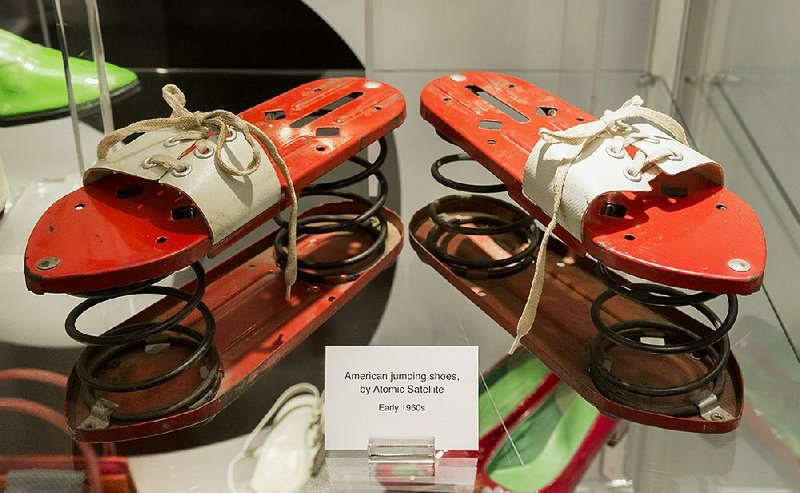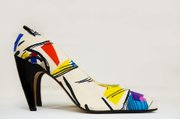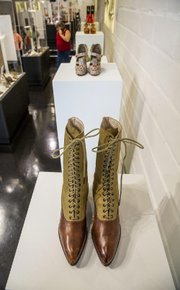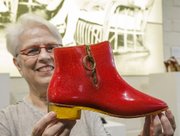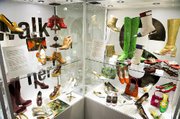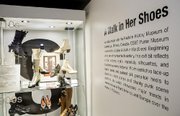I've spent $40,000 on shoes and I have no place to live? I will literally be the old woman who lived in her shoes!
Carrie Bradshaw, the fictional character from HBO's hit series Sex and the City, would surely be envious of a current exhibit at the Esse Purse Museum in downtown Little Rock -- "A Walk in Her Shoes." Even though no Manolo Blahniks (Bradshaw's faves) are included.
The special exhibit, which opened Oct. 11 and runs through Jan. 15, is on loan from a Canadian museum and traces the steps of the styles of American women's footwear throughout the last century.
"When skirts started going up and women had more to show, there became more interest in shoes," says Anita Davis, the museum's founder, about the early 20thcentury's rising hemlines.
Former first lady of the Philippines Imelda Marcos, who was known for her collection of 3,000 pairs of shoes and eventually driven into exile with her dictator husband Ferdinand during a 1986 revolt, would also probably adore this exhibit. It includes shoes, shoes and more shoes -- crafted by notable designers such as Christian Dior, Salvatore Ferragamo and Mary Quant to later leaders in footwear like Christian Louboutin, Thierry Mugler and Yves Saint Laurent.
Of the 50 pairs displayed, some are from haute couture lines, some originated in North and South America as well as the Caribbean and Asia. All come from the collection of the Fashion History Museum in Cambridge, Ontario, Canada, as well as the Esse Purse Museum, as collected by Davis for more than two decades. Esse partnered with the Canadian museum earlier this summer to host a temporary exhibit on the history of women's swimwear.
Since 2013, the Esse Purse Museum in Little Rock has explored the history of the American woman through its permanent exhibit, a century's worth of purses. Esse means "to be" in Latin, Davis says, adding that it signifies her belief that a purse contains the essence of the true being of a woman.
The museum, believed to be one of only three such museums in the world (the others are in Amsterdam and Seoul, South Korea), is a social history museum that aims to share the story of 20th-century women through purses and accessories. The permanent exhibit is divided into large display cases -- one for each decade.
The footwear exhibit examines the changing fashions and functions of women's shoes as well as the wide range of materials and silhouettes used in making them. The museum hopes the exhibit will raise societal questions, leading those who experience it to ponder women's evolving mobility, social positions and expressive choices.
Materials and styles range from delicate, feminine painted silk peep-toe heels to protective and restrictive lace-up leather boots. And fashions range from glamorous, sexy stiletto pumps to hardy, chunky platforms.
At the turn of the 20th century, women's shoes still reflected the need to protect feet and legs from the dirty, often unpaved streets; tall boots and fully enclosed shoes were common, Davis says. Daytime footwear of this time, hidden by long skirts, was mostly devoid of color and had low, sturdy heels.
-- Carrie Bradshaw
Esse Purse Museum & Store
1510 S. Main St., Little Rock
Hours: 11 a.m.-4 p.m. Tuesday-Saturday; 10 a.m.-3 p.m. Sunday. Closed Monday.
Admission: $10; $8 for senior citizens, students, and military. Ask about group rates.
(501) 916-9022
The display begins with a pair of shoes for each decade of the 20th century. The 1900s are represented by a pair of classic black leather, ankle-high lace-up leather boots labeled "Queen Quality" by the Thomas G. Plant Co. of Massachusetts. A similar style stands in for the 1910s, while the 1920s example is a more modern-day style pump, decorated with colorful leather appliques and a Mary Jane strap across the top of the foot.
The 1930s are represented with a pair of pumps of a new material -- green and gold silk and kid leather -- while the 1940s pair features brown suede and wool paisley.
Standing in for the 1950s is a pair of suede-and-rhinestone-studded Lucite open-toed and open-back pumps. Representing the 1960s is a pair of mod rubber-and-felt boots with a gold zipper on the side by Mary Quant. The 1970s are represented by a pair of Yves Saint Laurent knee-high olive suede boots while a pair of white printed cotton pumps with splashes of neon colors on abstract shapes stands in for the 1980s. The century concludes with a pair of Spanish black leather platform shoes from the 1990s.
The rest of the exhibit in a side gallery features glass cases divided by the decades, each filled with several pairs of shoes.
"This is just one more part of the history of women that we're telling here," Davis says.
Just a quick glance at the hues found in the cases for each decade is telling -- the 1900s case features all utilitarian tones of black and brown. As hemlines rose, so did the height of the boots. By the 1910s, a little color crept in with navy and white. The start of World War I shifted European shoe production from civilian to military footwear, and to save on leather, which was vital for military use, women's fashion boots began featuring suede and wool upper sections. By 1918, women's footwear shifted from boots to shoes except for the winter months.
By the 1920s, maroon, tans and even pastel floral patterns arrived. But the dire economic times of the 1930s brought a return of the dark and drab colors. Even in the midst of the Great Depression, brand name and cheaper shoe lines grew, expanding production and introducing more fashionable shoes. Also in the 1930s, sandals were introduced as another footwear option for women, first appearing on the beach and later appearing in daywear.
Despite World War II, during which shoe rations in the United States from 1943 through 1945 limited each man, woman and child to three pairs of leather shoes per year, vibrant colors such as fuchsia and orange were introduced.
Whimsical examples include a pair of platform sandals from the Philippines with an image of a house and palm tree cut out of the the shoe's sole.
And there are spring-loaded American jumping shoes by Atomic Satellite in the 1960s case.
"What's great about the exhibit is that it really demonstrates how you can get a lot of information about a society from its fashion," says Devin Hancock, program and collections manager for Esse.
During the '50s and '60s, electric, even neon, tones appeared. And in the mid-1950s, the stiletto heel arrived, replacing the wooden rod with metal to produce the thinnest heel possible. Dark hues returned for the '70s during which wood soles from the 1940s reappeared as clogs and platform shoes. In the '80s and '90s, brighter colors reappeared to close out the century.
"The design of the shoes says a lot about how women's mobility has changed through the century," Hancock says, adding that technological innovations allowed new materials to be introduced into footwear. "It shows how at first they couldn't move really well in the shoes they wore and how that evolved."
The exhibit also demonstrates how women went from having a limited amount of footwear at the beginning of the 20th century -- just what was needed -- to collecting shoes for the pure desire, as the Carrie Bradshaw character did at the close of it.
Hancock says, "We're hoping to show visitors how women have changed -- through both a social and economic perspective -- through the century and how fashion has changed along with us."
Style on 10/25/2016
